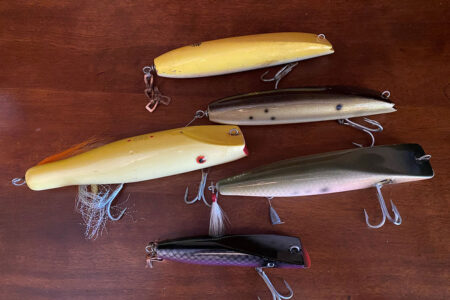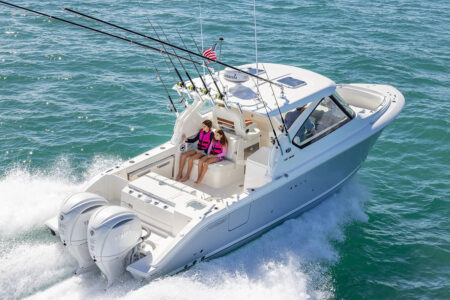
Weather permitting, the reef sites E/SE of Delaware Bay provide ample opportunity to bang blackfish this month.
Finding a good area to fish during the winter can be difficult. With sea bass season closed and stripers way down south, about the only fish left for most of the South Jersey and Delaware fleet is tautog.
As compared to Jersey’s 15-inch size and four fish bag through February 28, Delaware has a tog season that runs until March 31 with a 16-inch minimum size and a five fish bag limit. As a general rule, these fish will be caught within a 15- to 20-mile run from Lewes or Indian River over one of the many wrecks and reefs available in this general area.

Solid Structure
For folks on the south side of Delaware Bay, a good place to start targeting tog is one of the Delaware reef sites with their latitude and longitude available from the Delaware Division of Fish and Wildlife. The latest book containing these positions can be picked up at the Department of Natural Resources and Environmental Resources Building in Dover. You can call them at 302-739-9914.
All Delaware reefs are paid for using funds from the Delaware General Fishing License to match at a 3-1 ratio federal money collected from the excise tax levied on all fishing tackle. The head of Delaware’s reef program is Jeff Tinsman. Under his leadership Delaware has been able to use in kind credits to match some the federal money saving the tax paying fisherman a good deal of money.
There are four reefs located in the ocean off the Delaware Coast and all will hold tog. They have been designated as special zones preventing any commercial fishing with the exception of hook and line.
Reefs 9 and 10 are pretty close to Indian River Inlet and are made up of all sorts of junk. Concrete pipes and culverts were used at Site 9 with the same material plus a couple of small boats used at Site 10. Because they are so close to Indian River these reef sites get a lot of use. During the winter the pressure is considerably less, so I would not expect them to be crowded.
Site 11 was the first location to receive New York City Subway cars. The state dropped 714 of these cars along with ballasted tires, 66 military vehicles and eleven ships and boats. If I was to pick the best location for winter tog, Site 11 would be my first choice.
The site furthest from the inlet is the Del-Jersey-Land reef. This is where several larger ships have been sunk and where one of the ferries from the Cape May to Lewes run will be sunk in 2018. This site is currently covered up with black sea bass and unless they move off during the winter, it is hard to imagine getting a bait past them to a hungry tog.
Delaware is also home to several good tog producing wrecks. My personal favorite is the Washingtonian located at 38 27.423/74 47.18. There are several other wrecks about the same distance from Indian River and they can be found by checking Captain Seagull’s Chart ODMV21, Offshore Coastal Delaware, Maryland and Virginia.

Winter Wreckin’
The best time to go tog fishing in the winter is when the wind is not blowing above 15 knots. Sounds easy, but those days are a precious few. It would also be nice if we were experiencing a neap tide. Strong current is not conductive to bottom fishing of any kind.
In my experience, tog do not feed 24/7. If I could tell you exactly when they will get hungry I would buy a seat on the New York Stock Exchange and after about a week I could go fishing for the rest of my life.
Considering they don’t go outside their hidey hole when the current is running strong, I would guess that slack water would be a good time to catch tog. This is just a guess, and I am sure the next time you go tog fishing on a super moon when the current is running full bore you will limit out with every fish over 10 pounds.
Most of my tog have been caught when the boat was anchored; short of your electronics, the easiest way to set an anchor while tog fishing is to mark the structure with a float and from the float run several hundred yards before taking the boat out of gear and drifting back towards it. Continue a few hundred yards past the float then take note of your heading. Run past the float on the heading to set the anchor. How far past the float you will run depends on the depth of the water and on how much rode you will have to let out to hold bottom.
It is also possible to use a wreck anchor. Once again mark the structure with a float then move into the wind until you no longer mark the wreck or reef. Go a bit past this mark and drop the anchor. When the rode comes tight you should be directly over the wreck.
Using a wreck anchor has some danger connected to it. The rode will be pretty short so if seas are running high there is a possibility that one may break over the bow and swamp the boat. Never, ever secure a wreck anchor to the stern. In either case, if you are not marking heavy structure under the boat, go back and anchor again. Tog live in the heaviest mess of junk they can find and are seldom caught over open bottom.

Geared Up
Tackle for tog fishing is pretty much standard no matter where you fish. I tie my rigs with 50-pound Hi Seas mono fishing line. A perfection loop goes on one end and two dropper or surgeon’s loops, one for the hook and one for the sinker, are spaced an equal distance apart. The finished rig should be about 12 inches long.
I hate to admit it, but “Crazy” Alberto Knie gave me a good tip when it comes to making tog rigs; he ties an overhand knot between the sinker and the hook. Should the sinker get stuck to the bottom, the overhand knot will break and you can retrieve the hook and the fish. This is especially helpful when using braid because trying to break braided line can be a real chore.
I use Virginia style beak hooks for tog. This is one of the few times I don’t use circle hooks when fishing with bait. Tog don’t get the entire bait in their mouths before crushing it and expelling the shell. A circle hook works best on fish like striped bass and sea bass because they swallow the bait and the hook. The hook grabs the corner of the mouth as it exits the fish.
Another popular rig for tog – which honestly I have yet to try – is to have the hooks tied just above the sinker on 3- to 4-inch leaders. Once tied, you have the ability to use one large bait, such as big shrimp or green crab, or two smaller baits. Tog jigs, of course, have been more popular along the Jersey Coast in recent years and are sure to gain converts on the Delaware side as well!
Tog baits are crabs of whatever kind you can find. Green crabs or white leggers are favored in Delaware, but blue crab, clams, conk or fiddler crab also work. I’ve even caught tog on Stingsilver jigs in the past; last July in fact I caught six tog while jigging a Stingsilver for sea bass at the Washingtonian, two of which were over 16 inches. All six were hooked in the cheek, not the mouth.
Tog grow big off the Delaware coast; during the fall of 2017 we had fish over 16 pounds plus several 10- to 14-pounders. Come on down and give tog fishing in Delaware a try.
| MORE INFO – THE “DE” DEAL |
|---|
| If you trailer your own boat to Delaware you will need a fishing license and a ramp pass. You can also buy a boat license that covers you and anyone fishing on your boat. The cost of a non-resident general fishing license is $20 for the year. A non-resident boat license for boats over 20 feet is $50. A seven-day license is $12.50. The free Delaware FIN number is included in the license. To use a Delaware boat ramp you must be a Delaware resident or have a non-resident ramp certificate at a cost of $35. All licenses are available on line at www.fw.delaware.gov.
I have fished with folks who traveled down from New Jersey and New York. Most of them arrive the night before the trip, stay at one of the many hotels, fish one or two days and then head home. One way how many folks avoid paying for a license and a ramp certificate is to go out on a charter or head boat. This also relieves the pressure of finding a good location, buying bait and paying tolls for the boat trailer. There are some very good captains who have been fishing Delaware waters for a long time and can put you on the meat. |




